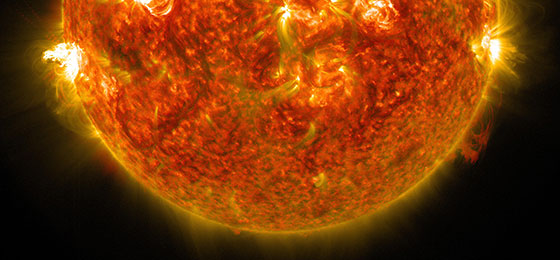Sun's impact on climate change quantified for first time

There is human-induced climate change, and there are natural climate fluctuations. One important factor in the unchanging rise and fall of the Earth's temperature and its different cycles is the sun. As its activity varies, so does the intensity of the sunlight that reaches us.
One of the key questions facing climate researchers is whether these fluctuations have any effect at all on the Earth's climate. IPCC reports assume that recent solar activity is insignificant for climate change, and that the same will apply to activity in the near future.
Researchers from the Physical Meteorological Observatory Davos (PMOD), the Swiss Federal Institute of Aquatic Science and Technology (EAWAG), ETH Zurich and the University of Bern are now qualifying this assumption. Their elaborate model calculations are supplying a robust estimate of the contribution that the sun is expected to make to temperature change in the next 100 years. For the first time, a significant effect is apparent. They expect the Earth's temperature to fall by half a degree when solar activity reaches its next minimum.
According to project head Werner Schmutz, who is also Director of PMOD, this reduction in temperature is significant, even though it will do little to compensate for human-induced climate change. “We could win valuable time if solar activity declines and slows the pace of global warming a little. That might help us to deal with the consequences of climate change.” But this will be no more than borrowed time, warns Schmutz, since the next minimum will inevitably be followed by a maximum.
Strong fluctuations could explain past climate
At the end of March, the researchers working on the project will meet in Davos for a conference to discuss the final results. The project brought together various research institutions' capabilities in terms of climate effect modelling. PMOD calculated what is known as “radiative forcing” taking account of particle as well as electromagnetic radiation, ETH Zurich worked out its further effects in the Earth's atmosphere and the University of Bern investigated the interactions between the atmosphere and oceans.
The Swiss researchers assumed a greater fluctuation in the radiation striking the Earth than previous models had done. Schmutz is convinced that “this is the only way that we can understand the natural fluctuations in our climate over the last few millennia.” He says that other hypotheses, such as the effect of major volcanic eruptions, are less conclusive.
Exactly how the sun will behave over the next few years remains a matter of speculation, however, since appropriate data series have only been available for a few decades and they reveal no evidence of fluctuations during this time. “To that extent, our latest results are still a hypothesis,” says Schmutz, “and it remains difficult for solar physicists to predict the next cycle.” But since we have been observing a consistently strong phase since 1950, it is highly likely that we will experience another low point in 50 to 100 years' time. It could be every bit as intense as the Maunder Minimum, which brought particularly cold weather during the 17th century.
Important historical data
The research project also placed great importance on the historical perspective. The Oeschger Centre for Climate Change Research at the University of Bern compared data series on past solar activity with other specific climatic conditions. People have been recording the number of sunspots, which correlates well with solar activity levels, for some three centuries now. However, it is much more difficult to quantify exactly how cold it was on Earth back then. “We know that the winters during the last minimum were very cold, at least in northern Europe,” says Schmutz. The researchers still have a fair amount of work to do before they have a detailed understanding of the relationship between solar activity and the global climate both in the past and in the future.
Sinergia: facilitating interdisciplinary research
The SNSF's Sinergia programme promotes collaboration between two to four research groups carrying out interdisciplinary research that is expected to deliver groundbreaking findings. Funding is dependent on the number of research groups and duration of the project and ranges from 50,000 to 3.2 million francs. Projects should last from one to four years.
Contact
Werner Schmutz
Physical Meteorological Observatory Davos
Dorfstrasse 33
CH-7260 Davos Dorf
E-mail werner.schmutz@pmodwrc.ch
Tel. +41 58 467 5145
http://www.snf.ch/en/researchinFocus/newsroom/Pages/news-170327-press-release-su…
http://p3.snf.ch/project-147659
http://www.snf.ch/SiteCollectionDocuments/Schmutz_Fupsol_publications.pdf Publications related to the research
http://www.snf.ch/press-releases
Media Contact
All latest news from the category: Earth Sciences
Earth Sciences (also referred to as Geosciences), which deals with basic issues surrounding our planet, plays a vital role in the area of energy and raw materials supply.
Earth Sciences comprises subjects such as geology, geography, geological informatics, paleontology, mineralogy, petrography, crystallography, geophysics, geodesy, glaciology, cartography, photogrammetry, meteorology and seismology, early-warning systems, earthquake research and polar research.
Newest articles

Making diamonds at ambient pressure
Scientists develop novel liquid metal alloy system to synthesize diamond under moderate conditions. Did you know that 99% of synthetic diamonds are currently produced using high-pressure and high-temperature (HPHT) methods?[2]…

Eruption of mega-magnetic star lights up nearby galaxy
Thanks to ESA satellites, an international team including UNIGE researchers has detected a giant eruption coming from a magnetar, an extremely magnetic neutron star. While ESA’s satellite INTEGRAL was observing…

Solving the riddle of the sphingolipids in coronary artery disease
Weill Cornell Medicine investigators have uncovered a way to unleash in blood vessels the protective effects of a type of fat-related molecule known as a sphingolipid, suggesting a promising new…





















